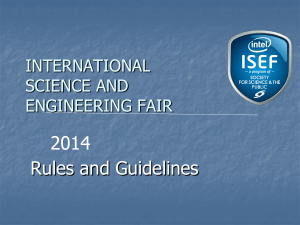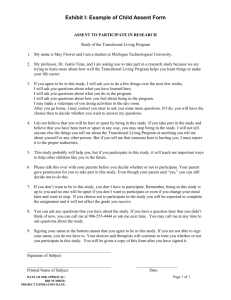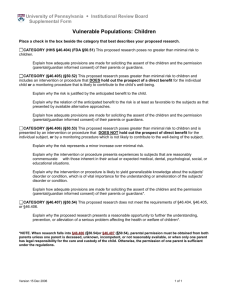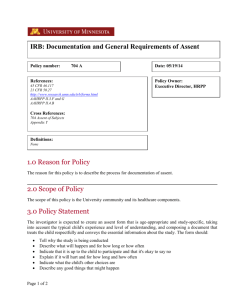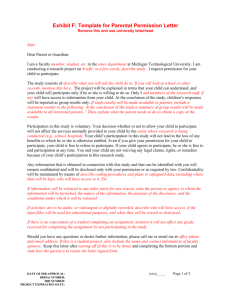Research Involving Children
advertisement
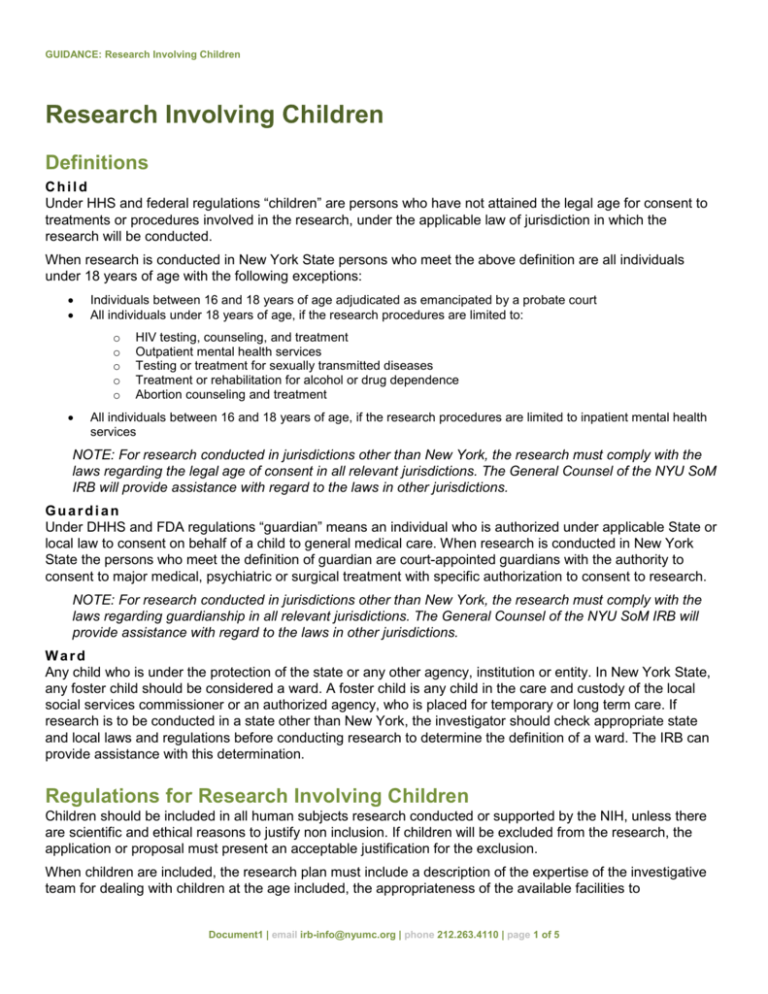
GUIDANCE: Research Involving Children Research Involving Children Definitions Child Under HHS and federal regulations “children” are persons who have not attained the legal age for consent to treatments or procedures involved in the research, under the applicable law of jurisdiction in which the research will be conducted. When research is conducted in New York State persons who meet the above definition are all individuals under 18 years of age with the following exceptions: Individuals between 16 and 18 years of age adjudicated as emancipated by a probate court All individuals under 18 years of age, if the research procedures are limited to: o o o o o HIV testing, counseling, and treatment Outpatient mental health services Testing or treatment for sexually transmitted diseases Treatment or rehabilitation for alcohol or drug dependence Abortion counseling and treatment All individuals between 16 and 18 years of age, if the research procedures are limited to inpatient mental health services NOTE: For research conducted in jurisdictions other than New York, the research must comply with the laws regarding the legal age of consent in all relevant jurisdictions. The General Counsel of the NYU SoM IRB will provide assistance with regard to the laws in other jurisdictions. Guardian Under DHHS and FDA regulations “guardian” means an individual who is authorized under applicable State or local law to consent on behalf of a child to general medical care. When research is conducted in New York State the persons who meet the definition of guardian are court-appointed guardians with the authority to consent to major medical, psychiatric or surgical treatment with specific authorization to consent to research. NOTE: For research conducted in jurisdictions other than New York, the research must comply with the laws regarding guardianship in all relevant jurisdictions. The General Counsel of the NYU SoM IRB will provide assistance with regard to the laws in other jurisdictions. Ward Any child who is under the protection of the state or any other agency, institution or entity. In New York State, any foster child should be considered a ward. A foster child is any child in the care and custody of the local social services commissioner or an authorized agency, who is placed for temporary or long term care. If research is to be conducted in a state other than New York, the investigator should check appropriate state and local laws and regulations before conducting research to determine the definition of a ward. The IRB can provide assistance with this determination. Regulations for Research Involving Children Children should be included in all human subjects research conducted or supported by the NIH, unless there are scientific and ethical reasons to justify non inclusion. If children will be excluded from the research, the application or proposal must present an acceptable justification for the exclusion. When children are included, the research plan must include a description of the expertise of the investigative team for dealing with children at the age included, the appropriateness of the available facilities to Document1 | email irb-info@nyumc.org | phone 212.263.4110 | page 1 of 5 GUIDANCE: Research Involving Children accommodate the children, the inclusion of a sufficient number of children to contribute to a meaningful analysis relative to the purpose of the study, and additional safeguards, as necessary. Categories of Research Children are a vulnerable research population and require additional protections when they are potential research subjects. Special ethical and regulatory considerations apply when reviewing research involving children. In New York State, any person under the age of 18 who is not married or a parent should be considered a child for the purposes of this Policy. The IRB, during the review process, must document the study as following into one of the below categories, pursuant to Subpart D of 45 CFR 46, based on the degree of risk and benefit to individual subjects: a. Research not involving greater than minimal risk (“Section 404 Research”), where adequate provisions are made for soliciting the assent of the children and the permission of their parents or guardians (See Child Assent below, Guidance Document on the Creation of an Assent Process/Document and Waiver of Parental Permission). b. Research involving greater than minimal risk, but presenting the prospect of direct benefit to the individual subjects (“Section 405 Research”). Section 405 Research is approvable only if: The risk is justified by the anticipated benefit to the subjects The relationship of the anticipated benefit to the risk is at least as favorable to the subjects as that presented by available alternative approaches Adequate provisions are made for soliciting assent of the children and permission of their parents or guardians (See Parental/Guardian Permission, Child Assent below). c. Research involving greater than minimal risk with no prospect of direct benefit to individual subjects, but likely to yield generalizable knowledge about the subject’s disorder or condition (“Section 406 Research”). Section 406 Research is approvable only if: The risk presents no more than a minor increase over minimal risk The intervention or procedure presents experiences to subjects that are reasonably commensurate with those inherent in their actual or expected medical, dental, psychological, social or educational situations The intervention or procedure is likely to yield generalizable knowledge about the subjects’ disorder or condition which is of vital importance for the understanding or amelioration of the subjects’ disorder or condition Adequate provisions are made for soliciting the assent of the children and permission of their parents or legal guardians (See Parental/Guardian Permission, Child Assent below) d. Research that does not fall into one of the three categories above, but which the IRB finds presents an opportunity to understand, prevent, or alleviate a serious problem affecting the health or welfare of children (“Section 407 Research”). Section 407 Research may only be conducted if the Secretary of DHHS, after consultation with a panel of experts in pertinent disciplines and following the opportunity of public review and comment, has determined that either: The research is Section 404 Research, Section 405 Research or Section 406 Research or The following conditions are met: o o o The research presents a reasonable opportunity to further the understanding, prevention or alleviation of a serious problem that affects the health and welfare of children The research will be conducted in accordance with ethical principles Adequate provisions are made for soliciting the assent of children and permission of their parents or guardians (See Parental/Guardian Permission, Child Assent below). The minutes of the relevant IRB Board meeting shall document the Subpart D category under which the protocol is approved, together with protocol-specific information which justifies the IRB’s finding. Document1 | email irb-info@nyumc.org | phone 212.263.4110 | page 2 of 5 GUIDANCE: Research Involving Children Submission Elements Necessary for IRB Review Information in the protocol must include the following information to ensure the IRB is able to determine the above findings: Complete Risk and Benefit information. All potential risks and benefits related to the research must be described. Without complete information the IRB will not be able to determine the category for approval of the study. Complete description of the Consent and Assent process. Information must be included regarding who, what, when, where and how the process/consent documentation will be completed. Wards Children who are Wards may be included in Section 404 Research or Section 405 Research. Children who are Wards may be included in Section 406 Research or Section 407 Research only if the IRB determines that such research is: Related to their status as wards or Conducted in schools, camps, hospitals, institutions or similar settings in which the majority of children involved as subjects are not Wards. Children who are Wards may not be enrolled in Section 406 Research or Section 407 Research without the express approval of the IRB. In New York City, if Wards are to be included in Section 406 Research or Section 407 Research, the Administration for Children’s Services (ACS) must be notified and agree to the inclusion of Wards in the study. In addition, permission for the enrollment of each Ward in the study must be obtained from the person designated by ACS to give such permission. If children who are Wards are to be included in any research study, the investigator must provide the IRB with detailed information about the proposed permission/assent process as well as the identity and authority of the individuals who will provide permission for the Ward subjects. IRB Review of Research Involving Wards If Wards are to be included in Section 406 Research or Section 407 Research, the IRB shall require appointment of an advocate for each Ward, in addition to any other individual acting on behalf of the child as guardian or in loco parentis. One individual may serve as advocate for more than one child. The advocate should be an individual who has the background and experience to act in the best interest of the child for the duration of the child’s participation in the study and who is not associated in any other way with the research, the investigator or the guardian organization. Exempt Research All of the categories of research which are exempt from review, are also exempt from review when they include children as research subjects except for: Research involving survey or interview procedures AND Observation of public behavior, unless the investigator does not participate in the activities being observed Informed Consent The consent form for children in research should be written as if you are speaking to the subject and the parents. This allows for the form to be used for information/presentation of the study with teens that may be considered “sophisticated’ or over the age of 14, who are able to comprehend the information included in the Document1 | email irb-info@nyumc.org | phone 212.263.4110 | page 3 of 5 GUIDANCE: Research Involving Children consent form. If this is the case, it is appropriate to include the assent signature page only instead of having a separated assent form. The consent form reading level should be no more than the eighth grade level. Example of how information should be written is: “You/Your child are/is being asked to participate in a research study. The purpose of the study is to evaluate a how safe and effective a new drug for headaches is. You/Your child are being asked to participate because you/your child are/is being seen for headaches. This research study is voluntary and you/your child do have to participate.” Parental/Guardian Permission, Child Assent Adequate provisions must be made for soliciting the permission of the parents or guardians of each child involved in a research study. In New York State, a guardian is defined as a person who has been appointed as a guardian of the child by: A parent pursuant to a designation, deed of guardianship or will approved by a Family Court or Surrogate’s Court judge OR A Family Court of Surrogate’s Court judge pursuant to a letter or order of guardianship All of the informed consent requirements also apply to obtaining parental/guardian permission and the appropriate informed consent elements must be included in a written informed consent. For information on requesting a Waiver of Parental Permission, please see the separate Guidance Document. If the IRB has not waived the requirement for parental permission, the permission of only one parent is acceptable for Section 404 Research or Section 405 Research unless the IRB determines otherwise. If the IRB has not waived the requirement for parental permission, the permission of both parents must be obtained for Section 406 Research or Section 407 Research unless: One parent is deceased, unknown, incompetent; or not reasonably available OR Only one parent has legal responsibility for the care and custody of the child If a person other than a parent signs an Informed Consent Document, the investigator should obtain documentary evidence that such person is the legally appointed guardian of the child or, in the case of Wards, that a state agency has guardianship of the child. If such documentation is not available, the investigator should call the IRB for assistance. A foster parent is not ordinarily authorized to provide parental or guardian permission. In NY State, there are two categories of children who may consent for them to be in a research study; (1) Emancipated minors and (2) mature minors. Emancipated Minor This may be applied for by the minor who will entitle those to be legally emancipated from his/her parent(s). The statutory age in which a minor can petition a court for emancipation is at least sixteen years or older but below the age of majority (which in NYS is eighteen years of age). Minors may also receive Automatic Emancipation and be under the age of majority. There are certain actions on their part that will cause them to be emancipated from their parents' care and control even without seeking a court order. These actions are limited to the following: Joining the armed forces Getting married Reaching the actual age of majority (which is usually eighteen years of age) Mature Minors Mature minors are those under 18, considered older minors who may sometimes be given decision-making capacity under what is known as the "Mature Minor Doctrine." This doctrine recognizes that in some cases a Document1 | email irb-info@nyumc.org | phone 212.263.4110 | page 4 of 5 GUIDANCE: Research Involving Children minor is mature enough to "appreciate the consequences of [his or] her actions" and accordingly places the power to decide in the hands of the minor. The determination of whether an adolescent is a mature minor involves such factors as the intelligence, age, maturity, and judgment of the minor as revealed by the circumstances of his or her life. Age alone must not be the determining factor. Maturity and judgment may be evident in the adolescent’s ability to demonstrate that he/she understands the risks and benefits of and alternatives to the medical service to be provided. The patient’s attending physician shall be responsible to ensure this assessment is made and documented in the patient’s medical record. For further information regarding the above, please see: NYU Hospitals Center Administrative Policy and Procedure on Minors- Consent and Treatment, effective 4/15/1985. If there is any doubt or question if the minor may consent for themselves or not, a parent or legal guardian should sign the consent form to be included in the research. The IRB may determine depending on the risk involved with the project, the signatures of both parents are required prior to the child enrolling in the study. Child Assent The IRB must find that adequate provisions are made for soliciting the assent of children when, in the judgment of the IRB, the children are capable of providing assent. In determining whether children are capable of assenting, the IRB shall take into account the ages, maturity, and psychological state of the children involved. When a child’s assent is required, the child should be given an explanation of the proposed research procedures in a language that is appropriate to the child’s age, experience, maturity and condition. The IRB may waive assent under the following circumstances: The capability of some or all of the children is so limited that they cannot reasonably be consulted The intervention or procedure involved in the research holds out a prospect of direct benefit that is important to the health or well-being of the children and is available only in the context of the research Even where the IRB determines that the children are capable of assenting, the IRB may waive the requirement for obtaining assent under circumstances in which consent may be waived as set forth in VI.B. of these Policies and Procedures When children are involved in research, the protocol generally must require the permission of the parent(s) and the assent of the child, if the IRB determines that the proposed child subject pool may be capable of providing assent. Factors that the IRB considers in determining whether all or some of the children may be capable of assenting to participation in a study include: the nature of the research the children’s age, status, and condition (e.g. whether the children can comprehend and appreciate what it means to be a volunteer for the benefit of others) the children’s experience and knowledge of clinical treatment (such as being a patient or being treated for illnesses of varying degrees of severity) the maturity and psychological state of the proposed subjects When the IRB determines that assent is required, it also determines that the provisions for obtaining and documenting assent are adequate. The child should be given an explanation of the proposed research procedures, the purpose of the research, and any discomforts, in a language that is appropriate to the child’s age, experience, maturity, and condition.Children should be asked if they wish to participate in the research, particularly if the research is not likely to be of any benefit to the children as subjects. A particular child subject’s capacity to assent must be evaluated on an individual basis by a knowledgeable professional. If appropriate, the IRB may require that either an IRB member or an advocate for the child be present during the assent in order to verify the child understands and may require that a parent or close family member be present during the research. Document1 | email irb-info@nyumc.org | phone 212.263.4110 | page 5 of 5
